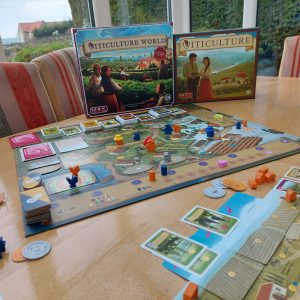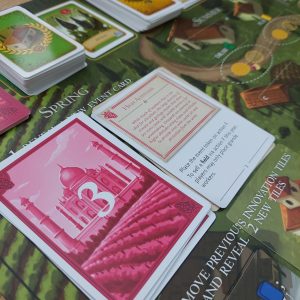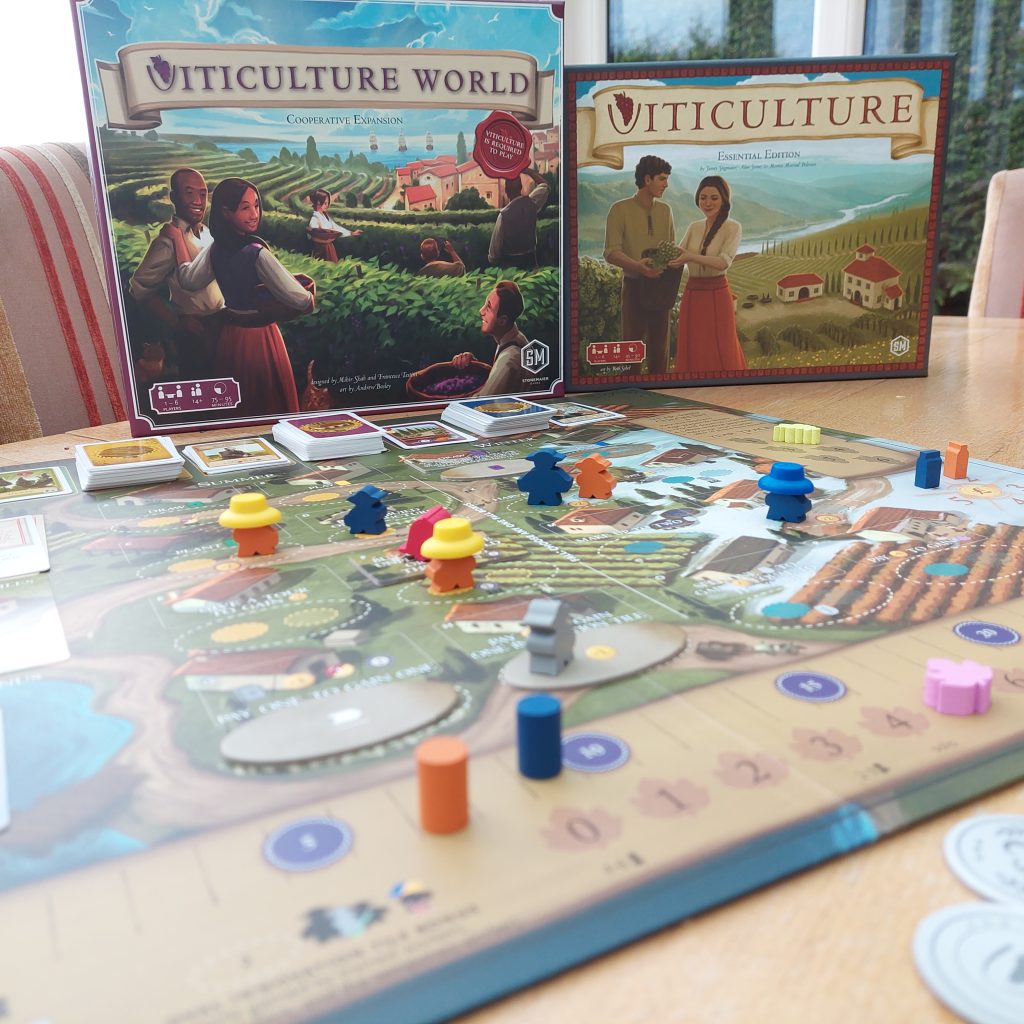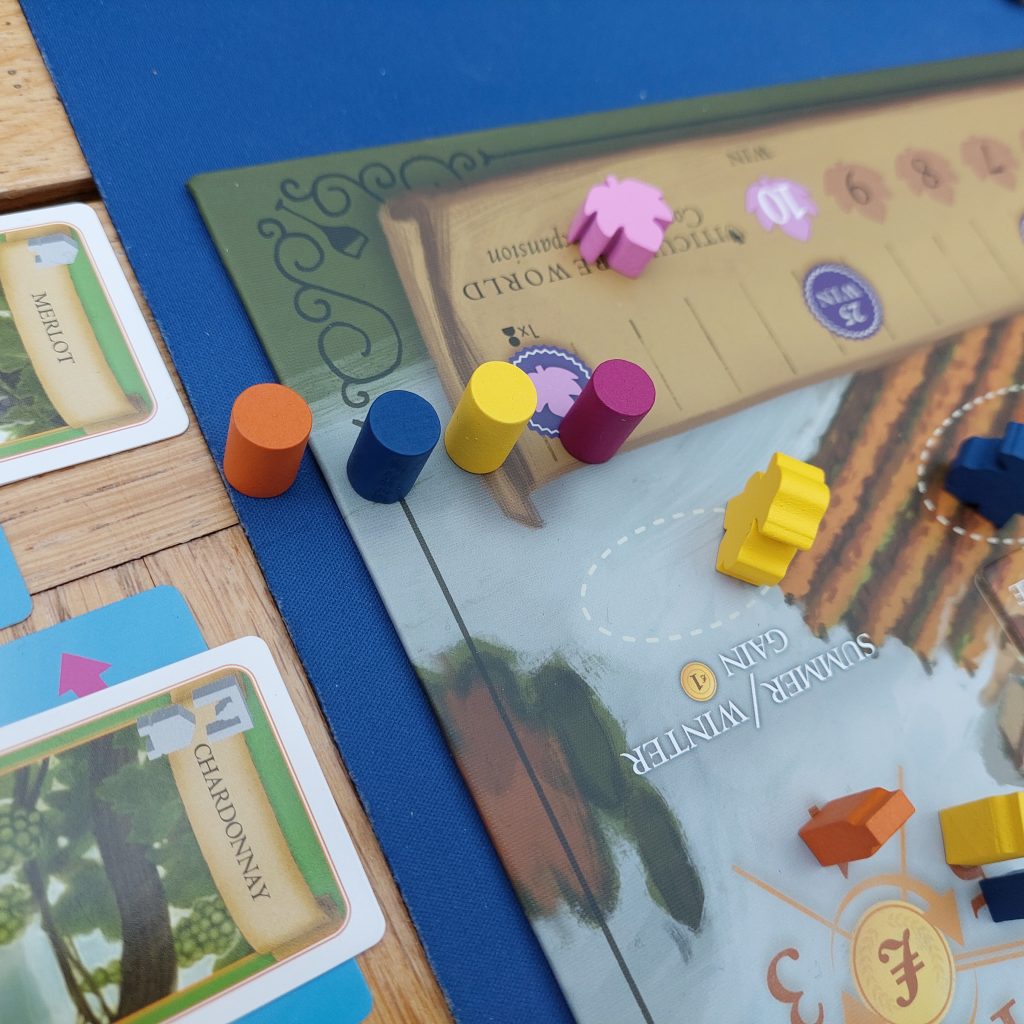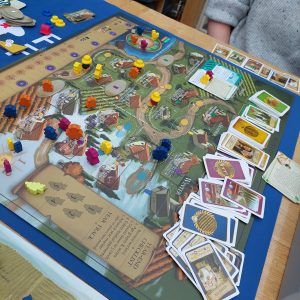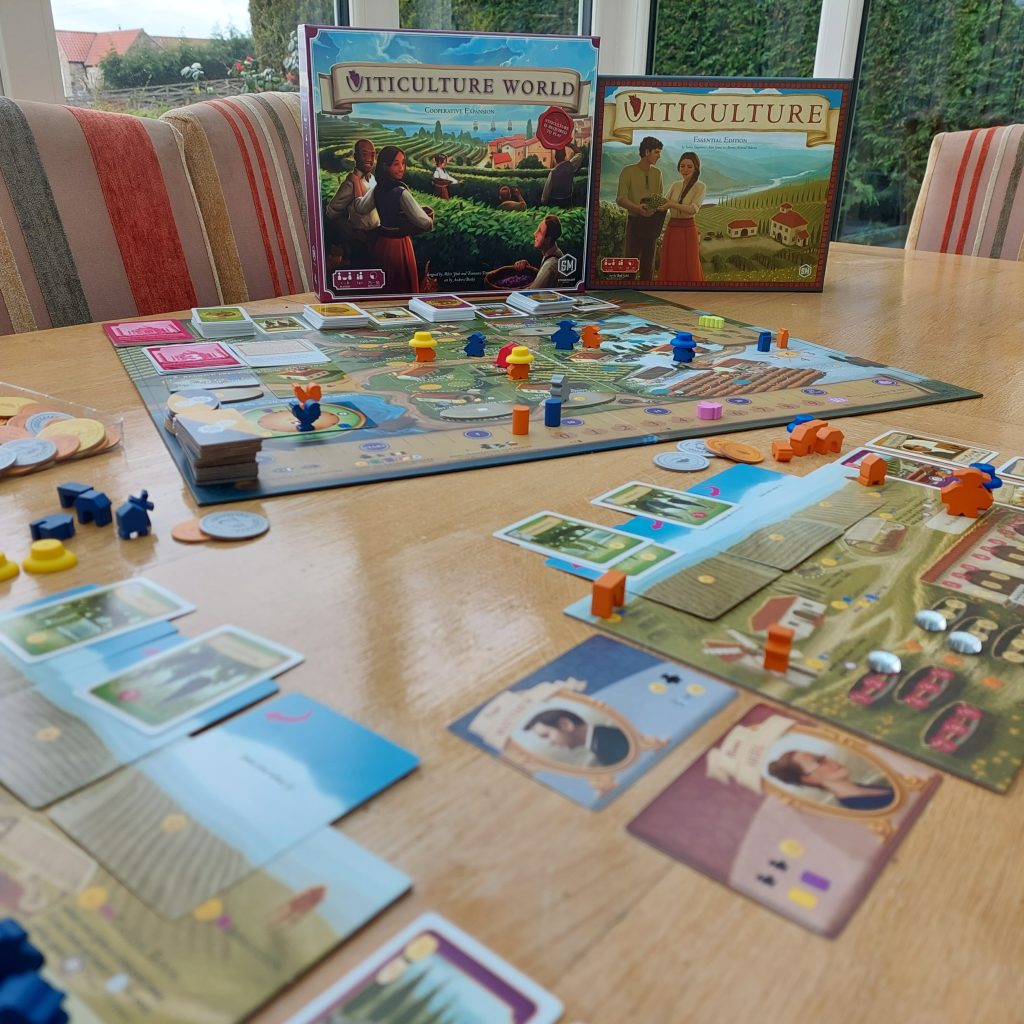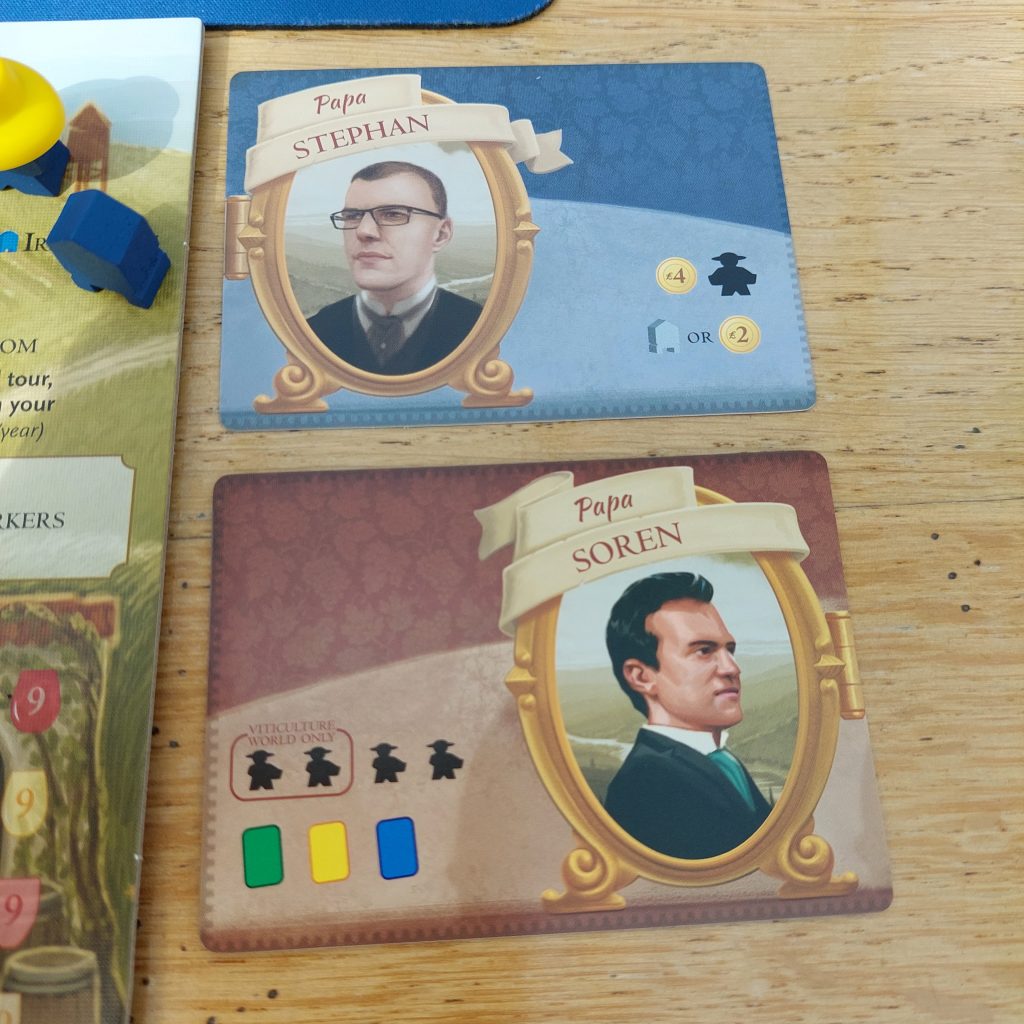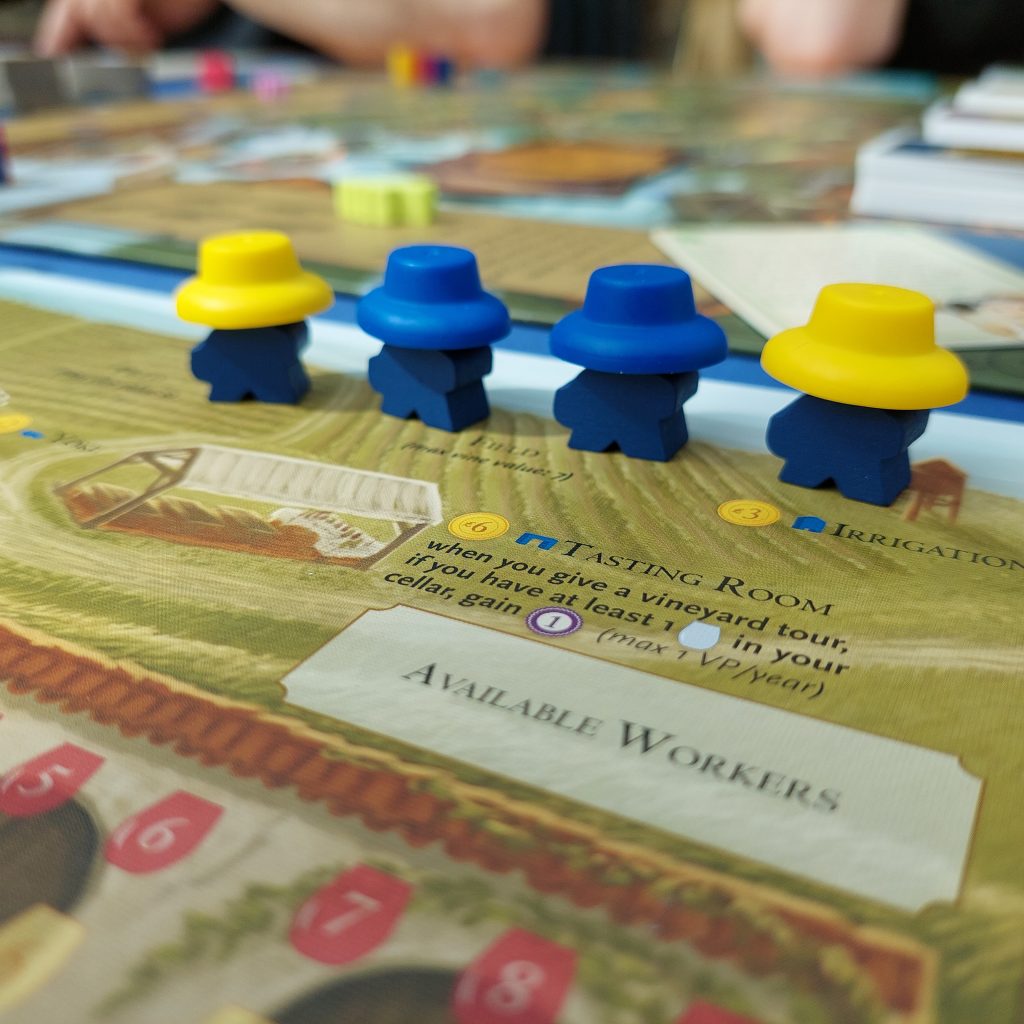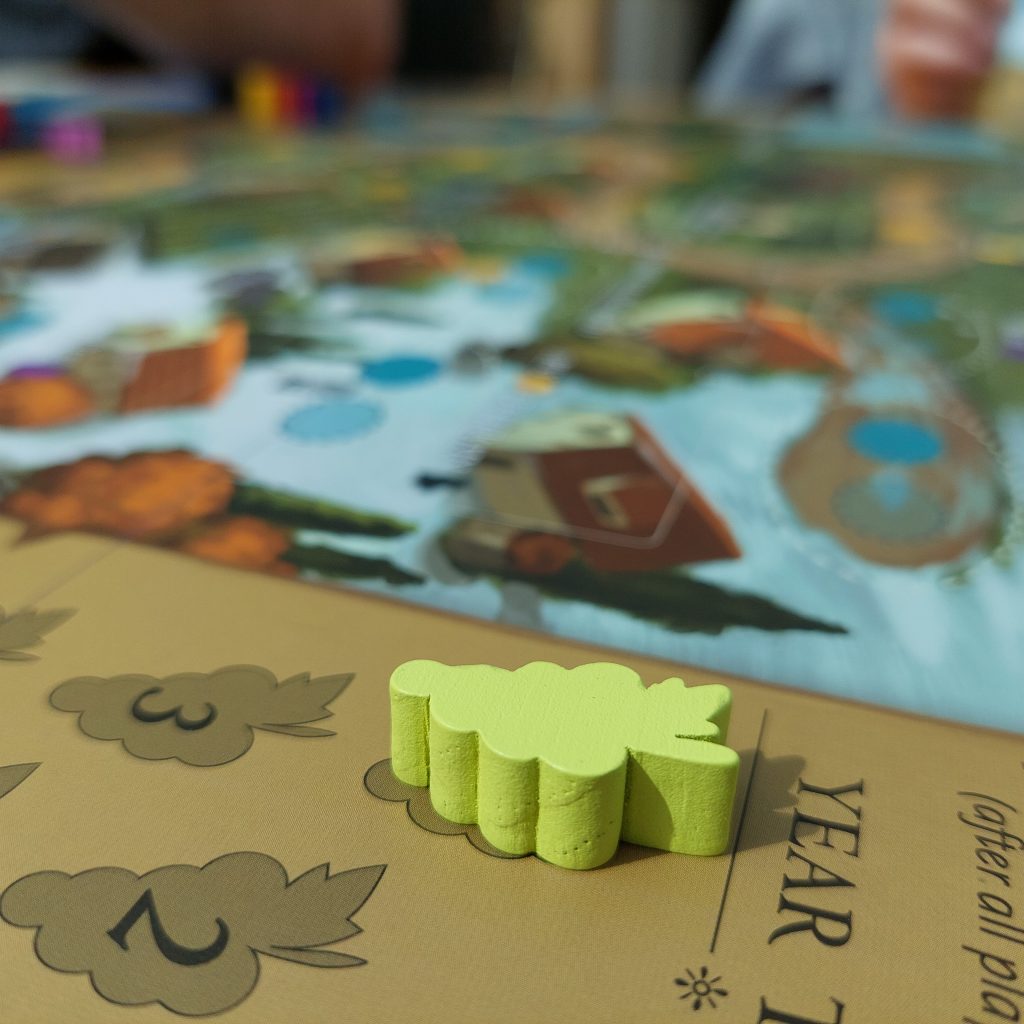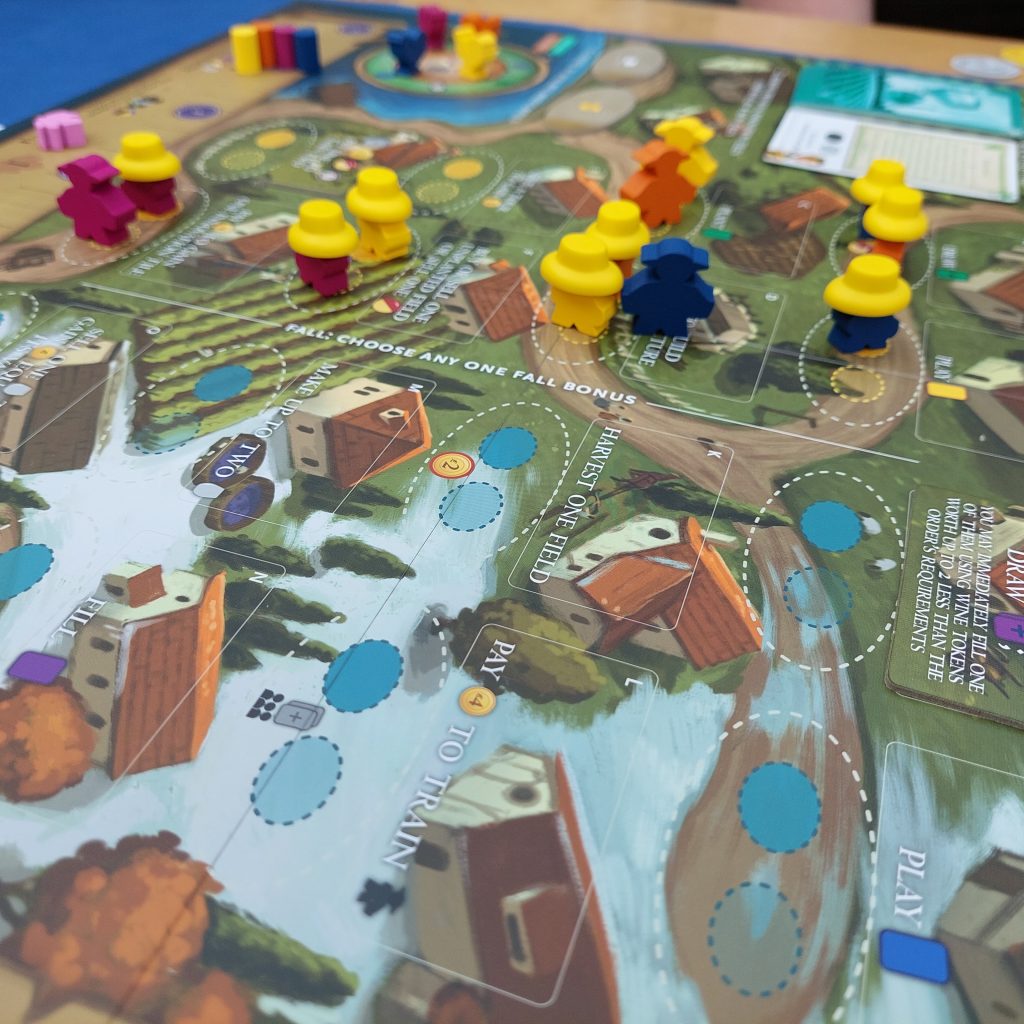Working together to make wines in Greengully and Asia, the Viticulture World expansion to Viticulture is a full-bodied co-operative adventure!
Publisher: Stonemaier Games
Designer: Mihir Shah, Francesco Testini
Artist: Andrew Bosley
Release date: 2022
1-6 players
60-120 minutes
NOTE: YOU WILL NEED A VITICULTURE BASE GAME TO PLAY (AND VITICULTURE WORLD IS COMPATIBLE WITH OTHER EXPANSIONS)
* Contracts *Worker Placement * Variable Turn Order * Resource Management * Card Drafting * Co-operative * Communication * Multi Player * Solo Mode * Automa Factory * Close Drafting * Victory Points as Resource
Confession time; as you can probably tell from my review of the base game, I think Viticulture (“Viti here for short) by Stonemaier Games is excellent. I love how every decision counts. I love how busy it gets at higher player counts, and how tactical and tight it is at two. And I love, despite the calm and tranquil styling, how competitive it is.
So when I was given the opportunity by Jamey Stegmaier to review their brand new co-operative expansion for Viticulture, Viticulture World, I didn’t know whether it would burn in the throat, or slide down like a cool, crisp, Chardonnay.
Luckily, to stop you hanging on the edge of your seats (come on now, I know you hang on my every word! ?, I get the chance to share our co-operative adventures with you! ?
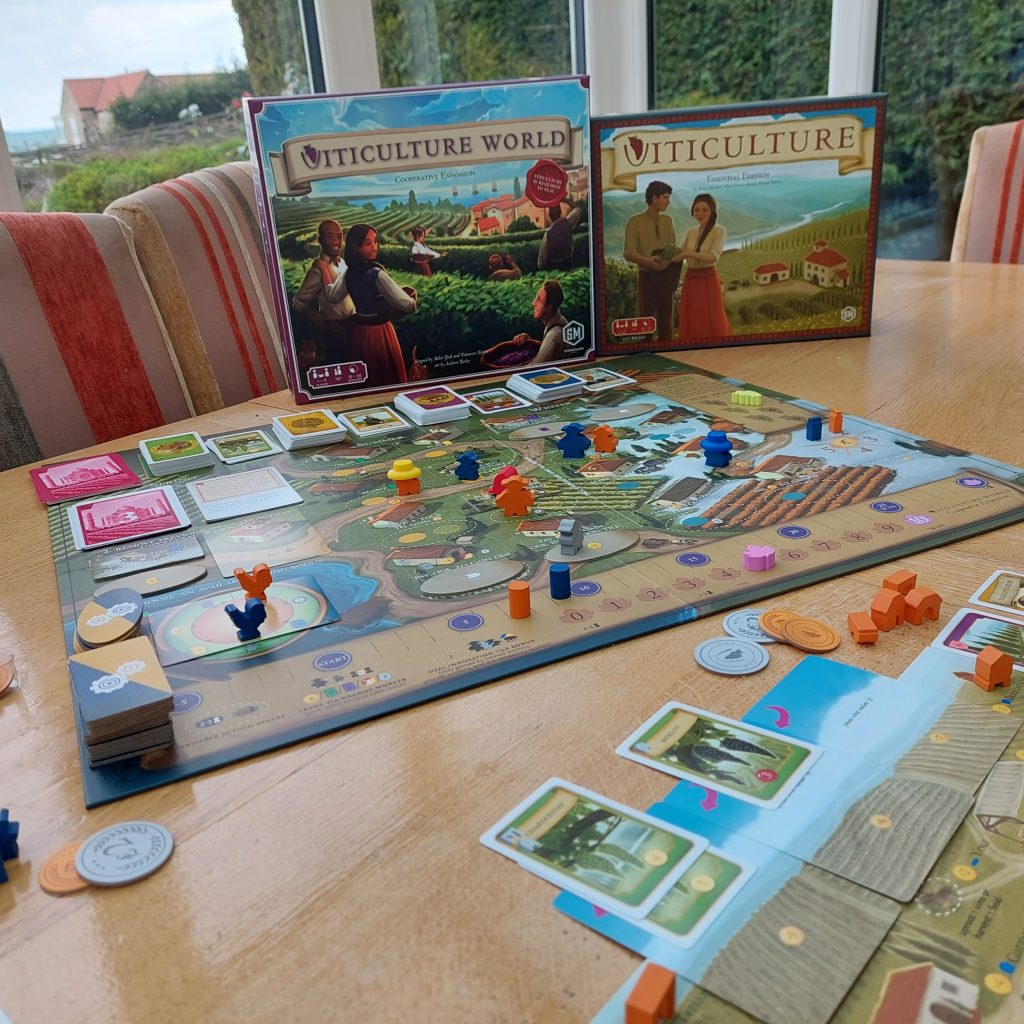
But before I pop the cork on our frolic through the vines, I just want to make clear that this is part 1 of our overall review. With 7 complete continents to play through (including the first game promo pack), Viticulture World is going to take some time to savour! And we don’t want to rush it.
There’s also going to be a re-print of some content currently included in the South America continent. Thanks to very brave, candid and open discussions between the fabulous Amy and Maggie (aka Thinker Themer) and Jamey Stonemaier (which you can watch and read about here and here) regarding the cultural and historical context of certain characters originally included in that particular scenario. If you weren’t aware, an issue was raised and a solution quickly implemented, but it takes time for new content to be shared. As such, to be fair to the gameplay and the team behind Viticulture World, we aren’t going to play on to South America until Stonemaier Games have had the chance to send out the new cards.
What this review is going to cover instead is our experience of playing Greengully (first game promo pack and sweet design crossover with Charterstone) and Asia (level: easy). I’m going to be cheeky and presume you know how to play Viti, but if you don’t, you may like to check out my full base game review first as some of the terminology might seem a little confusing!).
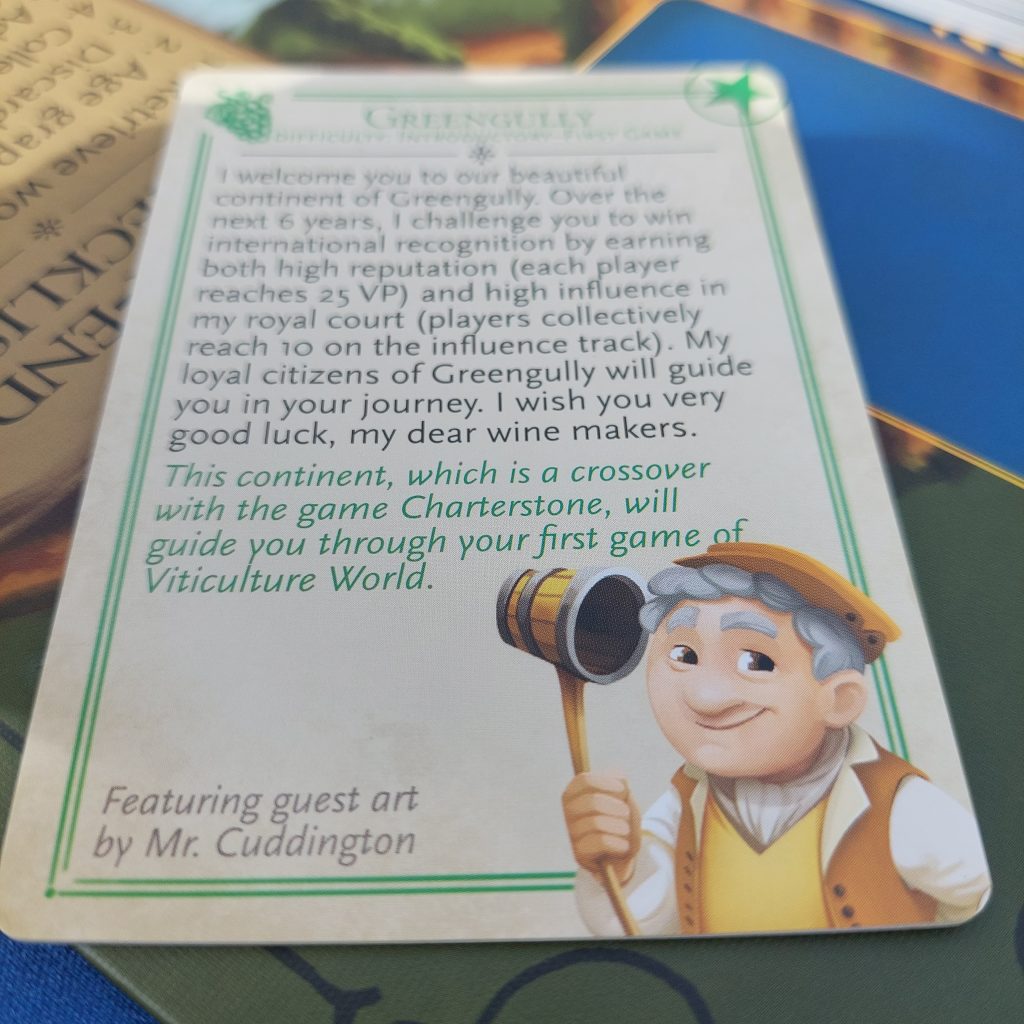
Winning Wines!
So, in Viticulture World, you’re working together with your extended family to run the best vineyard around. And to be considered the best, depending on player count, (a) each individual player needs to hit at least a specific number of victory points (VPs), and (b) the group needs to have achieved a certain score on the influence track by the end of the final year (round). Those are your basic collective goals. With a bunch of winemakers all working towards them, they sound simple, right? Well, as we quickly found out, they are not!
Greengully and Asia
Having ripped open the plastic wrap on the box and marvelled at the new board with 4 seasons (oooh!), there is some housekeeping to be done before you can set up your first game of Viticulture World.
Not much, but some of the Summer/Winter visitors need to be removed (as they aren’t much cop in co-op mode), your workers are going to get some very stylish (and well designed!) hats, and your mama and papa cards are going to get an overhaul. And these latter changes are for very good reasons.
Thanks to some integrated base/expansion shuffle action, and changing up the colours on the backs (blue and red), you can now choose far more inclusively – 2 mamas or 2 papas as well as one of each. And it wasn’t until I was able to do this that I realised that not being limited to heteronormative parents is how it should be (oh and just how much the character on the back of the papa cards looks like Tom Hiddleston aka Loki!? Or is that just me?).
The seasonal hats also amp up the challenge from the get-go. They assign your workers specifically to either the summer or winter season, limiting their placement possibilities and bonus collecting powers. You can of course invest in their training so that they can be trusted to work anywhere on the board, but you’re going to need some serious lire for that. There are also something called “Innovation tiles” to set out (more on this later), an influence leaf to place (that is going to make you sweat!!) , and……..lots of new continent cards to find, open, and stop yourself from reading through all in one go!

Continental Corkers!
Yep, each new continent has a pack of cards that acts as a narrative guide through that particular play. One card per year and 6 years per game. The continents each also have their own set up, so your board is likely to look a little different at the beginning of each one.
Flipping over and reading a new card each Spring (i.e. the beginning of each year) drew us in and carried us along our games so far. I think the idea is that they’re designed to take you through the years in a particular order, so that the innovations and events coincide with where you are (or should be) in the development of your vineyard. Maximum impact achievable.
But once familiar with that continent, you can play it again – this isn’t a legacy game after all. And you can play the cards in the same order or you can muddle them up to make the game and events even more challenging. Plus, as some continents have more than 6 cards in their pack, but your game plays out over 6 rounds, you can include cards that wouldn’t strictly be in every game that plays the cards in strict 1-6 number order.
Greengully is designed to be the easiest continent, and the first game promo pack is definitely a hand-holding experience in terms of how the new game style and elements work. Even though I haven’t played Charterstone (where Greengully is set), I liked following along with the storyline as it related to our wine producing adventure.
But, as we found out, even that is no cake-walk (or should I say grape-walk!?). We were sweating around the end of year 4, looking at a player who was still down around the 15VP mark and an influence leaf that was stuck mid-way on 5. We knew we had to raise our game to achieve both goals of 25VPs each and an influence of 10. Thankfully we did! But this game is a journey, not just a dusty, wine making destination.
Asia was the same. We tried this continent at 2 player count to see whether we could cope without our co-op compadres! It was definitely tougher on our own (even though it was still an “easy” difficulty continent), but a lot of that was down to our ongoing deep set desire to win……alone…….!
The event cards in Asia are really interesting too. As well as adding restrictions/possibilities on the main board for a given year, the numbered cards are used to overlay and change parts of the board itself (like changing up the bonuses on the wake up circle and blocking off an entire innovation token slot)!

Winners All Round!
Viticulture World is co-operative. But, just like the base game, you each still have your own fields, equipment, and workers to manage within the now communal commercial setting. There’s no single set of workers or buildings or fields to ponder over. And that means you’re still ultimately in charge of your own stuff.
There’s an individual tension that seeps through the team dynamic throughout a game (or it did during ours at any rate!). But with no official incentive for one player to strive to come out on top after the game has been beaten, it doesn’t feel semi-cooperative either.
We only got over the line in Greengully and Asia because of a definite and difficult mental shift towards yielding to the greater good in the latter part of each game played. With our individual player boards, workers, and wine making opportunities, our first 3 years in both scenarios were indeed stained by the grapes of old – the competitive, familiar player approach in Viti. And in Asia that was despite having the benefit of experiencing Greengully!
I wonder whether Viticulture World would feel different when played by gamers who regularly play as a team. As I have mentioned before, @shadowmeeplemedia and I are normally gunning for each other (particularly sweeeet in Viti 2 player mode!) rather than working together.
Having said that, however, even our two super gaming pals (and very seasoned co-operative players) found themselves torn at times between going for actions that were better for all and those that would boost their own position in Greengully. Plus, i suppose, if there was no individual targets for everybody to get behind (weakest link in the chain style), I’m not sure the game would click.
Either way, I had to learn very quickly how to dial down the rivalry and start thinking as one. Simply laying our hands of cards face up, and choosing together where each of us started on the wake up wheel each Spring were definite sea-changes in playing style. And trading (which includes just giving away) cards/resources to another player when sharing spaces with their Grande worker felt alien at first, but definitely screamed co-operation. Unfamiliar territory but necessary for victory overall.
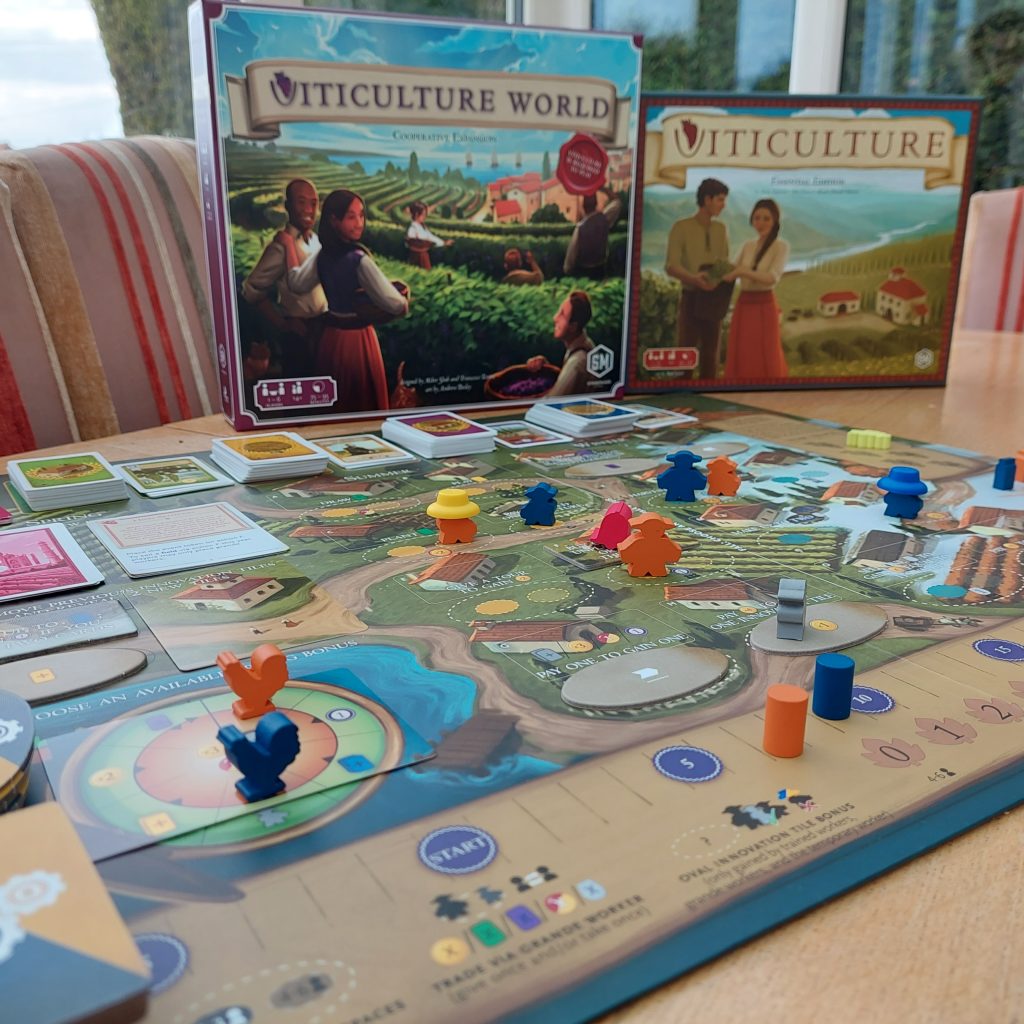
Super Strength Vino!
Notwithstanding the above, everyone has things they are good at, as well as things they aren’t. And the umpteen routes to victory in Viti are multiple and well-trodden. Whether you go hard on wine production, or raise your VP total in other ways, each is a viable strategy no less worthy than another.
And the style of co-operative worker placement play in Viticulture World definitely allows (and dare I say it, needs) different strategies to meld together. No doubt, the theme in Viti is centred around running a winning winery. For some, I realise that should mean pumping out boxes of bottles and fulfilling orders. But sometimes, as in real life, it could also means holding off on production when the economic conditions aren’t right. So, weird as it sounds, wine isn’t always necessarily the way to go to win.
Hence, in Viticulture World, to get everybody over the line, that divide-and-conquer approach could therefore in fact be the point; using the competitive skills learnt in Viti and turning them against the game itself. some going wild on wine making with others focussing on different elements of vineyard management (training, construction, tours).
We definitely took advantage of some players not producing every year – deciding together for them to go heavy on construction or coin collecting when we knew a big investment or planting session was due down the line. It was also helpful for someone to be raising big money when combined with an innovation tile that effectively let us buy our way to 10 influence!
And I think that is a great example of the unusual co-operative spirit in Viticulture World; a game that requires you to exploit your own strengths at just the right time to raise the collective experience. It’s a game that forces you to become comfortable making moves that might initially feel like you’re “taking hits for the team”. But what is actually happening is that you are leveraging your position or your resources at a key moment in such a way that brings everyone further along the journey to victory.
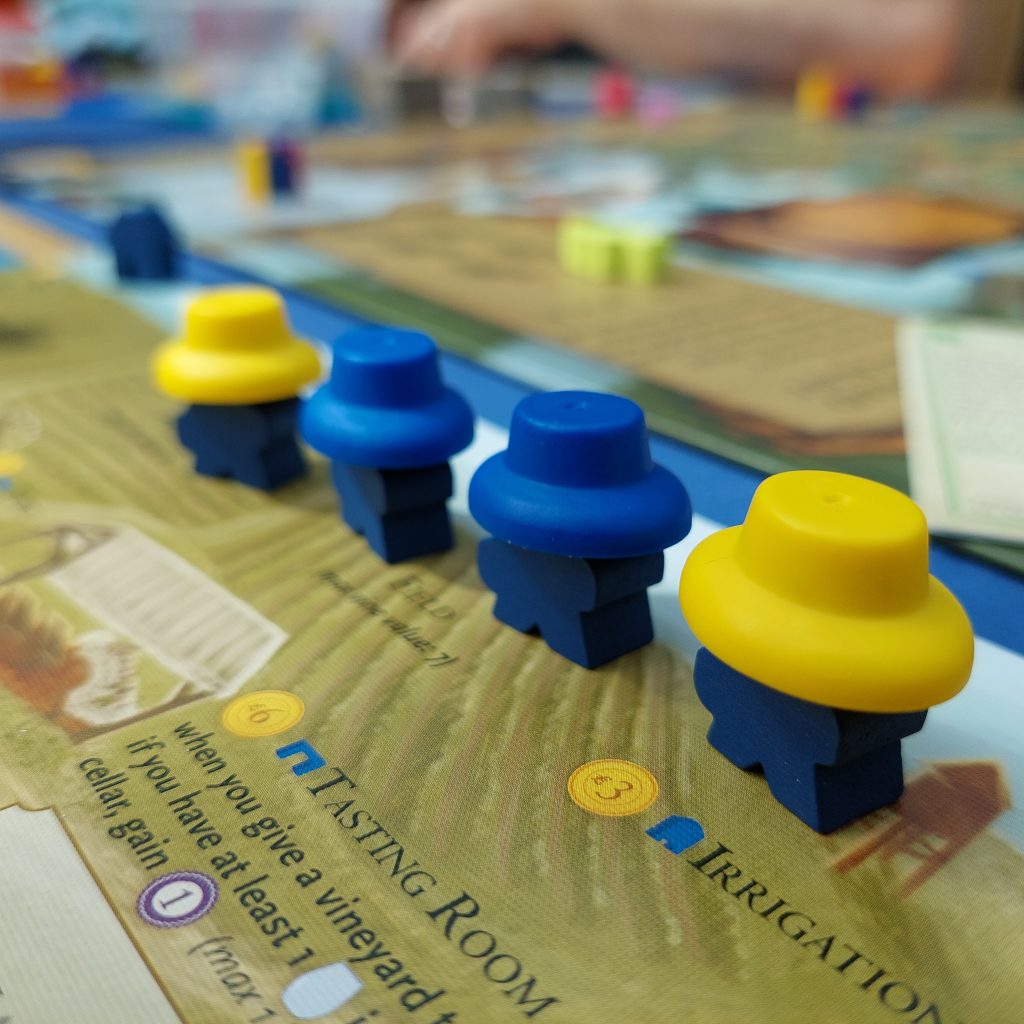
Innovative Flavours!
The biggest mechanical changes for us in Viticulture World has been the introduction of the innovation tiles and events – these get revealed every Spring. In the two continents we have played so far, they have shaken things up. If you can and choose to activate innovation spaces or acquire innovation tiles (which is not always possible to begin with), they power up specific actions and worker spaces in the Summer or Winter seasons. The rectangular ones upgrade particular actions for the rest of the game. And once oval innovation tiles are placed, there’s no limit to how many workers can land there and use the action as well as gain the bonus (if they are trained, that is!).
With no standard bonuses on the oval action spaces pre-printed on the board (unlike Viti), and only two or even one space per action (depending on player count) on a standard space, we found selecting (and placing) the right ones at the right time really pivotal. In nearly every case it was worth it after factoring in their activation bonus for trained workers/initial cost to place/chain adjacency power crossing seasons. Especially in Asia where the event cards themselves encouraged going heavy on upgrading.
No doubt, some innovations feel more powerful than others. And in truth they are what took us out of our year 4 slump in Greengully for sure. But we still had to be tactical to make use of them, and with all the other restrictions and added challenges in the co-op game play, they didn’t feel like they unbalanced the game overall. Plus the cost to get them can be high (too high sometimes depending on when they come up), and the trade-off later in the year can feel steep. But, because the actions they offer stay there once triggered, your team can use them more than once. And as the years play out, with (theoretically!) more resources at your disposal, you should be able to exploit them for even more returns. It also makes the board feel dynamic – where you choose to boost actions and open up worker spaces will be different for each time you play the same continent as well as for each continent you play.
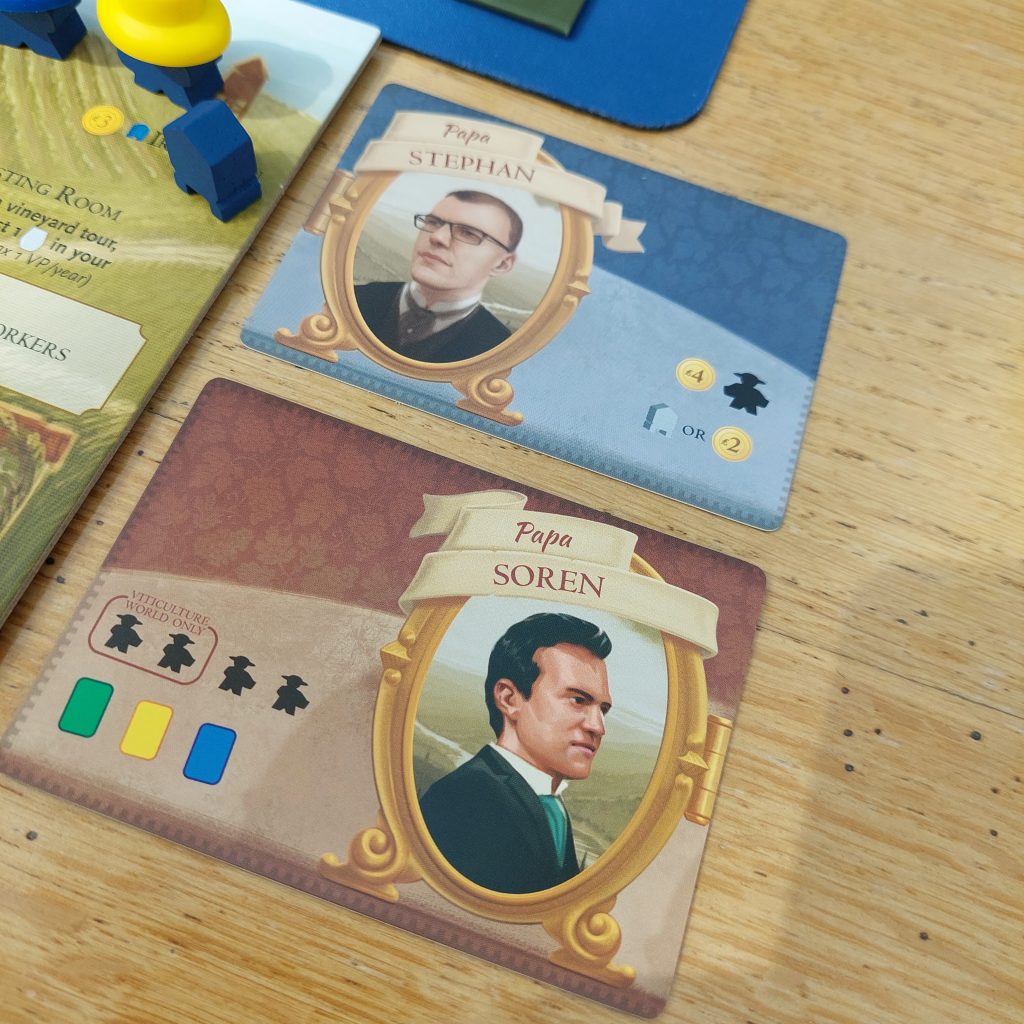
A World of Wines!
Okay, so we haven’t circumnavigated the world with our winemaking yet, but 2 continents in and the different experience that is co-operative Viti is already making its mark on us. I would say right now the only thing that I wish could be a little better is the rule book – despite knowing the base game and having lots of clues on the board itself, some queries did come up and the rule book wasn’t always as helpful as we have come to know from Stonemaier Games. Luckily, however, there are always helpful discussions on Board Game Geek and Facebook, and Jamey and his team are always very proactive in responding to questions and providing clarifications. The rest of the components are top-notch Stonemaier classic quality – those little hats are especially awesome! And there is even an automa to enable Viticulture World to be played alone which has to be the complete package, no?!
Without doubt, we have found the first two continents Viticulture World a more challenging experience than regular Viti. And I fully confess that it could be in part because the purely competitive approach in the base game is so ingrained in me that it has been hard to adapt those skills in pursuit of the greater good. In fact, in both scenarios we carried on playing beyond reaching 25VPs each and 10 influence just to see who could make maximum use of their remaining resources at the end of the 6th year. You can take the players out of the competition, but you can’t take the competition out of the players! Haha
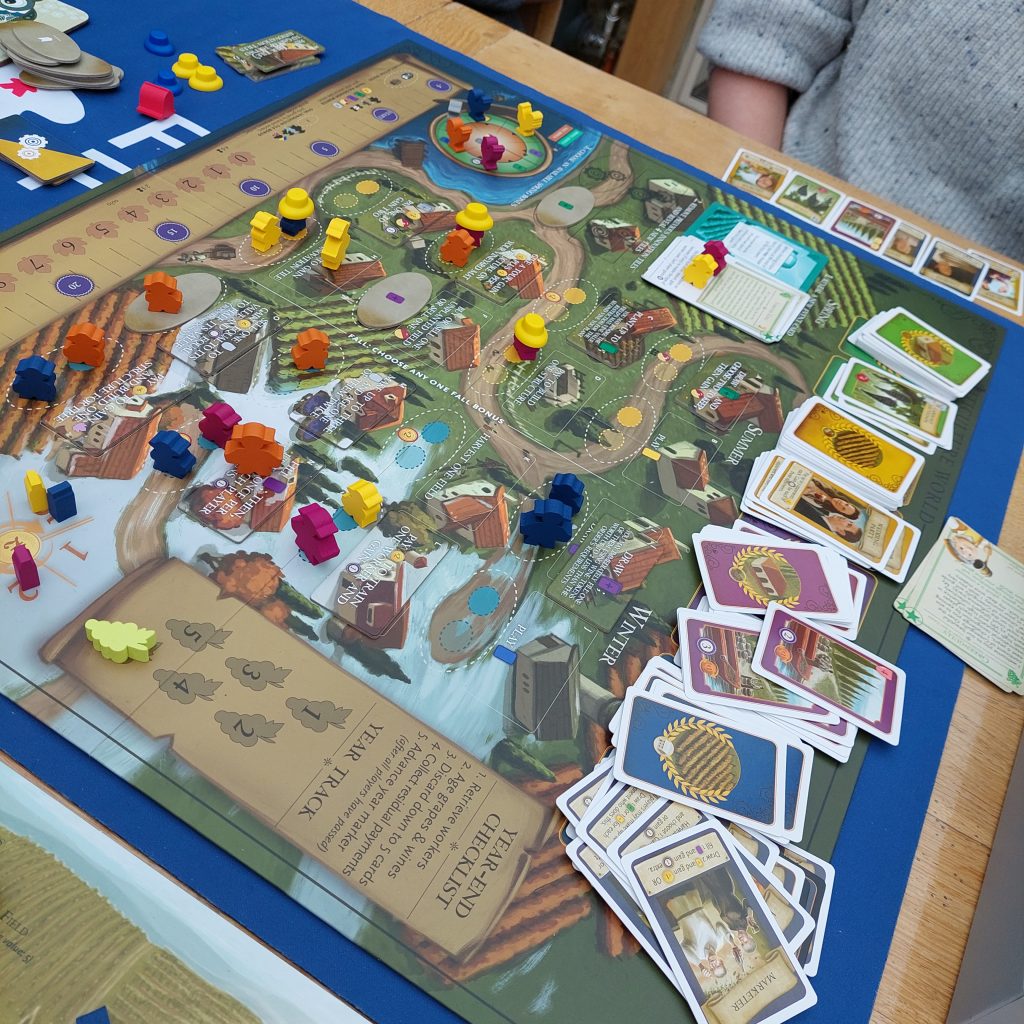
But so far there seems to be lots of little details and tight tweaks in Viticulture World that encourages, nay, forces co-operative game play. Seasonal workers, limited Visitor cards, fewer worker spaces……Small changes from Viti that don’t seem impactful on their own but chain together to make it impossible to win without submitting fully to a group dynamic. Changes that are good when working WITH people on the samewavelength (Hey! anybody fancy a trade??).
And on reflection, perhaps Viticulture World can’t go deeper into the semi-co-operative zone anyway. Not even if you could technically come first overall after the game itself had been beaten. And I think maybe that is because player decisions made during the game intent on keeping some of your powder dry would ruin the spirit in which this latest expansion has been designed. It would drift too far away from the focus being upon co-operation and into . And that’s fine, because Viti offers the perfect competitive experience if being and beating your fellow oenophiles when that is what you want out of a game based on the same theme. But who knows. As we continue our worldwide wine tour, other thoughts could materialise.
Either way, we are definitely looking forward to exploring more continents together and smashing that VP and influence target as we go! Looking at the rule book, we have some tough challenges ahead; Oceania, South America, Europe and North America are “medium” difficulty and Africa promises to be an even tougher grape to squash!
[Please note that a copy of this game was kindly provided by the publishers for review. I am not paid for my comments, however, and all opinions are my own]. I am also not affiliated to or sponsored by any retail store.


